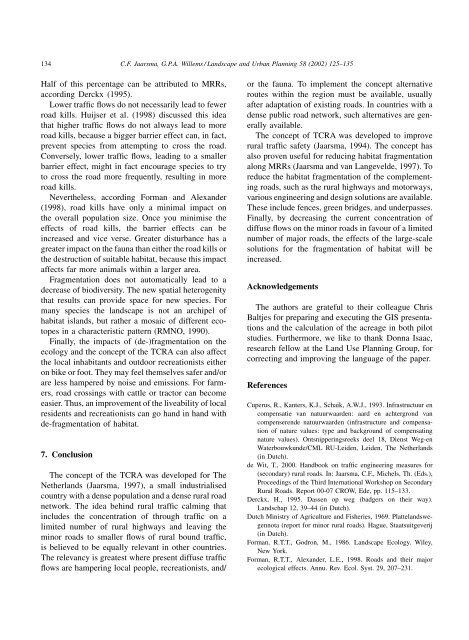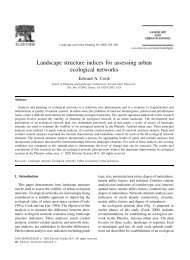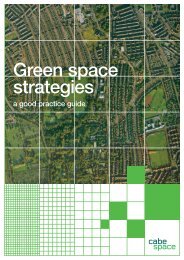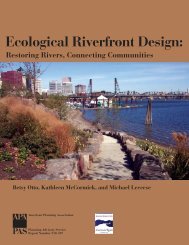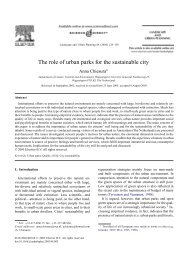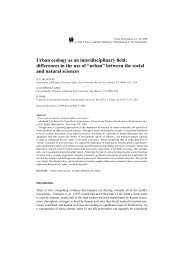134 C.F. Jaarsma, G.P.A. Willems / Landscape and Urban Planning 58 (2002) 125–135Half of this percentage can be attributed to MRRs,according Derckx (1995).Lower <strong>traffic</strong> flows do not necessarily lead to fewerroad kills. Huijser et al. (1998) discussed this ideathat higher <strong>traffic</strong> flows do not always lead to moreroad kills, because a bigger barrier effect can, in fact,prevent species from attempting to cross the road.Conversely, lower <strong>traffic</strong> flows, leading to a smallerbarrier effect, might in fact encourage species to tryto cross the road more frequently, resulting in moreroad kills.Nevertheless, according Forman and Alexander(1998), road kills have only a minimal impact onthe overall population size. Once you minimise theeffects of road kills, the barrier effects can beincreased and vice verse. Greater disturbance has agreater impact on the fauna than either the road kills orthe destruction of suitable <strong>habitat</strong>, because this impactaffects far more animals within a larger area.Fragmentation does not automatically lead to adecrease of biodiversity. The new spatial heterogenitythat results can provide space for new species. Formany species the landscape is not an archipel of<strong>habitat</strong> islands, but rather a mosaic of different ecotopesin a characteristic pattern (RMNO, 1990).Finally, the impacts of (de-)<strong>fragmentation</strong> on theecology and the concept of the TCRA can also affectthe local inhabitants and outdoor recreationists eitheron bike or foot. They may feel themselves safer and/orare less hampered <strong>by</strong> noise and emissions. For farmers,road crossings with cattle or tractor can becomeeasier. Thus, an improvement of the liveability of localresidents and recreationists can go hand in hand withde-<strong>fragmentation</strong> of <strong>habitat</strong>.7. ConclusionThe concept of the TCRA was developed for TheNetherlands (Jaarsma, 1997), a small industrialisedcountry with a dense population and a dense <strong>rural</strong> roadnetwork. The idea behind <strong>rural</strong> <strong>traffic</strong> calming thatincludes the concentration of <strong>through</strong> <strong>traffic</strong> on alimited number of <strong>rural</strong> highways and leaving the<strong>minor</strong> <strong>roads</strong> to smaller flows of <strong>rural</strong> bound <strong>traffic</strong>,is believed to be equally relevant in other countries.The relevancy is greatest where present diffuse <strong>traffic</strong>flows are hampering local people, recreationists, and/or the fauna. To implement the concept alternativeroutes within the region must be available, usuallyafter adaptation of existing <strong>roads</strong>. In countries with adense public road network, such alternatives are generallyavailable.The concept of TCRA was developed to improve<strong>rural</strong> <strong>traffic</strong> safety (Jaarsma, 1994). The concept hasalso proven useful for reducing <strong>habitat</strong> <strong>fragmentation</strong>along MRRs (Jaarsma and van Langevelde, 1997). Toreduce the <strong>habitat</strong> <strong>fragmentation</strong> of the complementing<strong>roads</strong>, such as the <strong>rural</strong> highways and motorways,various engineering and design solutions are available.These include fences, green bridges, and underpasses.Finally, <strong>by</strong> decreasing the current concentration ofdiffuse flows on the <strong>minor</strong> <strong>roads</strong> in favour of a limitednumber of major <strong>roads</strong>, the effects of the large-scalesolutions for the <strong>fragmentation</strong> of <strong>habitat</strong> will beincreased.AcknowledgementsThe authors are grateful to their colleague ChrisBaltjes for preparing and executing the GIS presentationsand the calculation of the acreage in both pilotstudies. Furthermore, we like to thank Donna Isaac,research fellow at the Land Use Planning Group, forcorrecting and improving the language of the paper.ReferencesCuperus, R., Kanters, K.J., Schaik, A.W.J., 1993. Infrastructuur encompensatie van natuurwaarden: aard en achtergrond vancompenserende natuurwaarden (infrastructure and compensationof nature values: type and background of compensatingnature values). Ontsnipperingsreeks deel 18, Dienst Weg-enWaterbouwkunde/CML RU-Leiden, Leiden, The Netherlands(in Dutch).de Wit, T., 2000. Handbook on <strong>traffic</strong> engineering measures for(secondary) <strong>rural</strong> <strong>roads</strong>. In: Jaarsma, C.F., Michels, Th. (Eds.),Proceedings of the Third International Workshop on SecondaryRural Roads. Report 00-07 CROW, Ede, pp. 115–133.Derckx, H., 1995. Dassen op weg (badgers on their way).Landschap 12, 39–44 (in Dutch).Dutch Ministry of Agriculture and Fisheries, 1969. Plattelandswegennota(report for <strong>minor</strong> <strong>rural</strong> <strong>roads</strong>). Hague, Staatsuitgeverij(in Dutch).Forman, R.T.T., Godron, M., 1986. Landscape Ecology. Wiley,New York.Forman, R.T.T., Alexander, L.E., 1998. Roads and their majorecological effects. Annu. Rev. Ecol. Syst. 29, 207–231.
C.F. Jaarsma, G.P.A. Willems / Landscape and Urban Planning 58 (2002) 125–135 135Huijser, M.P., Bergers, P.J.M., Ter Braak, C.J.F., 1998. Hetvoorkomen van doodgereden egels in relatie tot de samenstellingvan het landschap (the prevention of road kills ofhedgehogs in relation to the composition of the landscape).Ontsnipperingsreeks deel 37, Dienst Weg-en Waterbouwkunde(in Dutch).Jaarsma, C.F., 1994. Rural low-<strong>traffic</strong> <strong>roads</strong> (LTRs): the challengefor improvement of <strong>traffic</strong> safety for all road users. In:Proceedings for the Dedicated Conference on Road and VehicleSafety, 27th ISATA, Aachen, Germany, 31 October–4 November,pp. 177–183.Jaarsma, C.F., 1997. Approaches for the planning of <strong>rural</strong> roadnetworks according to sustainable land use planning. LandscapeUrban Plan. 39 (1), 47–54.Jaarsma, C.F., 2000. Sustainable land use planning and planning of<strong>rural</strong> road networks. Agric. Eng. Int.: CIGR Electronic J. Sci.Res. Dev. II, 1–12, http://www.agen.tamu.edu/cigr.Jaarsma, C.F., Michels, Th., 1989. Verkeersplanning in landelijkegebieden: methode voor het kwantificeren van verkeerskundigeeffecten, toegepast op het Binnenveld (<strong>traffic</strong> planning in <strong>rural</strong>areas: a method for quantifying impacts of changing flows,applied in the Binnenveld region). SC-rapport 23, Wageningen(in Dutch).Jaarsma, C.F., van Langevelde, F., 1997. Right-of-way managementand <strong>habitat</strong> <strong>fragmentation</strong>: an integral approach with thespatial concept of the <strong>traffic</strong> calmed <strong>rural</strong> area. In: Proceedingsof the 6th International Symposium on Environmental Concernsin Rights-of-Way Management, New Orleans, LA, 24–26February. Elsevier, Amsterdam, pp. 383–392.Jaarsma, C.F., Kessels, J.C.H.M., 1999. Environment and <strong>rural</strong><strong>roads</strong>: a GIS supported integral planning. In: Proceedings of theInternational Conference on Agricultural Engineering, AgEng,Oslo 98, Oslo, 24–27 August 1998.Jaarsma, C.F., Willems, G.P.A., 2001. GIS as a tool to addressenvironmental issues in rights-of-way planning and management:the example of <strong>rural</strong> road networks. In: Goodrich-Mahoney, J., Mutrie, D., Guild, C. (Eds.), Proceedings of the7th International Symposium on Environmental Concerns inRights-of-Way Management, Calgary, September 2000. Elsevier,Amsterdam, in press.Jaarsma, C.F., Luimstra, J.O.K., de Wit, T.J., 1995. De kortste wegnaar een verkeersleefbaar platteland. Onderzoek ruraal verblijfsgebiedOoststellingwerf (the shortest way to a livable <strong>rural</strong>area. A <strong>traffic</strong> and transportation plan for a residential <strong>rural</strong> areain Ooststellingwerf). Nota vakgroep Ruimtelijke Planvorming58, Wageningen (in Dutch).Jaarsma, C.F., Jongman, R.H.G., Kamphorst, D.A., 2000. Versnippering/ontsnipperingdoor wegen en verkeer vanuit eenWagenings perspectief (<strong>fragmentation</strong>/de-<strong>fragmentation</strong> <strong>by</strong><strong>roads</strong> and <strong>traffic</strong> from a Wageningen perspective). Bundelingvan bijdragen Wageningen Universiteit aan het nationalerapport versnippering/ontsnippering (COST 341). Nota VakgroepRuimtelijke Planvorming 86, Wageningen (in Dutch).Klerks, R.P.R., Verweij, J.A.W., 1994. Effecten van versnipperingdoor plattelandswegen op fauna (effects of <strong>fragmentation</strong><strong>by</strong> <strong>rural</strong> <strong>roads</strong> at fauna). Thesis, Vakgroep RuimtelijkePlanvorming, Landbouwuniversiteit, Wageningen (in Dutch).Logemann, D., Schoorl, E.F., 1988. Verbindingswegen voor planten dier (corridors for plant and animal). Utrecht, Amsterdam (inDutch).MacArthur, R.H., Wilson, E.O., 1967. The Theory of IslandBiogeography. Princeton University Press, Princeton.Macpherson, G., 1993. Highway and Transportation Engineeringand Planning. Longman, Harlow, UK.Merriam, H.G., 1984. Connectivity: a fundamental characteristic oflandscape pattern. In: Brandt, J., Agger, P. (Eds.), Methodologyin Landscape Ecological Research and Planning. Theme 1:Landscape Ecological Concepts, Vol. 1. Roskilde UniversityCentre, Denmark, pp. 5–15.Opdam, P., 1987. De metapopulatie: model van een populatie ineen versnipperd landschap (the metapopulation: model of apopulation in a fragmented landscape). Landschap 4 (4), 298–306 (in Dutch).RMNO (Raad voor het Milieu-en NatuurOnderzoek), 1990. Deversnippering van het Nederlandse landschap (the <strong>fragmentation</strong>of the Dutch landscape). Onderzoeksprogrammering vanuitzes disciplinaire benaderingen. Publikatie, RMNO No. 45 (inDutch).van der Fluit, N., Cuperus, R., Canters, K.J., 1990. Mitigerende encompenserende maatregelen aan het hoofdwegennet voor hetbevorderen van natuurwaarden (mitigating and compensatingmeasures to the major road network for helping nature values).CML Mededelingen 65, Centrum voor Milieukunde, RijksuniversiteitLeiden (in Dutch).van Langevelde, F., Jaarsma, C.F., 1997. Habitat <strong>fragmentation</strong>, therole of <strong>minor</strong> <strong>rural</strong> <strong>roads</strong> and their traversability. In: Canters,K.J., Piepers, A., Hendriks-Heersma, D. (Eds.), HabitatFragmentation and Infrastructure. Proceedings of the InternationalConference on Habitat Fragmentation, Infrastructure andthe Role of Ecological Engineering, Maastricht/Hague, TheNetherlands, 17–21 September 1995, pp. 171–182.Verboom, J., 1994. Een modelstudie naar de effecten vaninfrastructuur op dispersiebewegingen van dieren (a modelstudy of the effects of infrastructure of fauna dispersal).Rijkswaterstaat/IBN-DLO, Delft/Wageningen (in Dutch).Wiertz, J., 1991. De dassenpopulatie in Nederland in 1960–1990(the badgerpopulation in The Netherlands in 1960–1990).Rapport 91/6, Rijksinstituut voor natuurbeheer, Leersum (inDutch).Catharinus F. Jaarsma is a senior lecturer at the WageningenUniversity, Land Use Planning Group. His research and his coursesfocus on <strong>rural</strong> road and <strong>traffic</strong> planning for several types of landuse. Growing attention for environmental aspects and <strong>habitat</strong><strong>fragmentation</strong> have given new impulses to <strong>rural</strong> <strong>traffic</strong> research,within the wider perspective of environmental circumstances.Geert P.A. Willems graduated in Land Use and Spatial Planning atWageningen University in 1999. In 2000, he joined the Land UsePlanning Group of Wageningen University as a research fellow. Hisresearch focuses on the ecological, environmental and safetyimpacts of infrastructure in <strong>rural</strong> areas.


